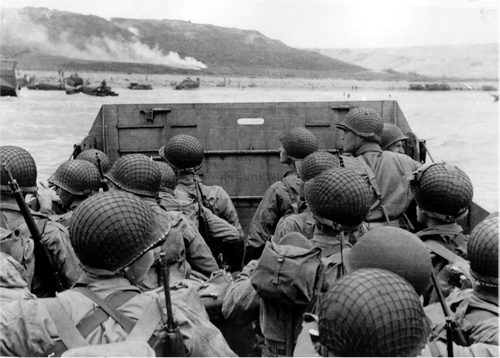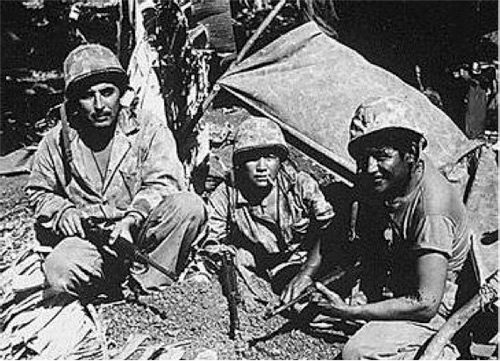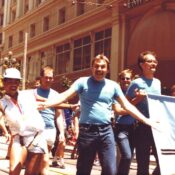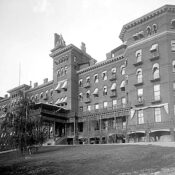This column by American studies professor Ben Railton explores the connections between America’s past and present.
The June 6, 1944, Allied landing on France’s Normandy Beach—the operation that came to be known as D-Day—was one of the most ambitious military operations ever undertaken, and featured countless stories of striking bravery and heroism. To cite just one example from my home state, Virginia’s state highway 29 has been officially designated the “29th Infantry Division Memorial Highway,” in honor of a unit based out of the state’s Fort Belvoir that served in the vanguard at Normandy, suffered tremendous casualties as a result, and then helped lead the subsequent advance through France and into Germany that produced the final Allied victory over the Nazis.

No doubt because of such remarkable stories, as well as the invasion’s central importance to the war effort, D-Day has figured prominently in our national collective memories of the war. From early cultural portrayals like the blockbuster films D-Day: The Sixth of June (1956) and The Longest Day (1962) to more recent ones such as the bravura opening sequence of Steven Spielberg’s Saving Private Ryan (1998) and the acclaimed HBO miniseries Band of Brothers (2001), popular culture has returned to the histories of D-Day and its aftermath time and again.
Those histories, and most especially all those Allied servicemen who took part in them, are certainly well worth commemorating, and the operation’s anniversary provides an opportunity to do so once more. Yet there are many other World War II feats of heroism that extend beyond the Normandy invasion, including a number featuring soldiers of color who (because of the military’s segregated status) were not allowed to take part in the D-Day operation. Adding them to our commemorations deepens our perspective on what every American community contributed to the cause.
Thanks to director John Woo’s historical film Windtalkers (2002), the stories of the World War II Navajo code talkers — stories that were classified until 1968 and largely unremembered until at least the 1980s — have perhaps begun to enter our collective memories, but nonetheless deserve a far fuller presence in our histories of the war. Recruited in 1941 and 1942 by Philip Johnston, a World War I veteran who had grown up on a Navajo reservation and spoke the language, these Navajo soldiers —some as young as 15 or 16 years old — proved vital to the Allied efforts, especially in the war’s Pacific Theater. Major Howard Connor, a signal officer who served with the 5th Marine Division at the crucial 1945 Battle of Iwo Jima, later argued that, “Were it not for the Navajos, the Marines would never have taken Iwo Jima.”

African American servicemen likewise contributed mightily to the Allied efforts. Despite their absence from combat roles in — and thus most cultural representations of — the Normandy invasion, African American soldiers such as those in the 320th Barrage Balloon Battalion did indeed take part in the D-Day operation. And both before and after June , 1944, African American units played vital roles in combat operations throughout the war. The Tuskegee Airmen, also known as the Red Tails (the title of a 2012 historical film about the unit that deserves wider viewership), flew tens of thousands of missions in North Africa, Italy, and beyond. The 761st Tank Battalion, also known as the Black Panthers, saw extensive combat under General George Patton in the post-Normandy Battle of the Bulge, among many other European operations, and have been called “one of the most effective tank battalions in World War II.”

Native Americans and African Americans have played significant roles in every American military conflict from the Revolution on, and these World War II servicemen extended and amplified those profoundly impressive histories. But perhaps the most inspiring and heroic World War II American servicemen of color were the Japanese American soldiers who quite literally volunteered from within the exclusionary internment camps and helped change the course of the war.
In early 1943, roughly a year after President Franklin D. Roosevelt’s Executive Order 9066 had created the internment policy, the administration reversed its concurrent policy prohibiting Japanese Americans from serving in the armed forces. The move was both a practical and a cynical one, both a response to wartime needs and an attempt to counter Japanese propaganda about the camps, and it would have been understandable if Japanese Americans had refused to serve the nation that had defined them as “alien enemies.” But their response was instead literally and figuratively overwhelming: in Hawaii, an initial call for 1500 volunteers led 10,000 Japanese Americans to recruiting offices; while more than 2000 volunteered in that initial surge from within internment camps.
By the war’s end, more than 33,000 Japanese Americans had served in two segregated units, the 442nd Infantry Regimental Combat Team and the 100th Infantry Battalion. The 100th, the first unit to see combat in 1943 (initially in Italy and then throughout Europe), came to be known as the “Purple Heart Battalion,” as it took nearly 10,000 casualties by war’s end. And Commanding General George Marshall said of the 442nd, who fought under his command throughout the pivotal post-Normandy campaigns in 1944, that “They were superb! They showed rare courage and tremendous fighting spirit. Everybody wanted them.”

D-Day was a crucial wartime operation, but it has become a great deal more than that. It rightly serves as an occasion through which to remember the service, bravery, and heroism of American World War II servicemen and veterans. Adding the stories of the Navajo code talkers, the war’s African American units, and the Japanese American soldiers of the 442nd and 100th to our national collective memories not only amplifies those commemorations of heroism, but makes clear how much every American community share
Become a Saturday Evening Post member and enjoy unlimited access. Subscribe now




Comments
Thanks for the comment, Larry. With all due respect, one of my main points here is precisely the opposite: that it was the diversity of both America and its armed forces that was vital to the US victory in WWII, as it has been to every one of our military campaigns (see this War of 1812 story, to cite just one example: http://americanstudier.blogspot.com/2014/05/may-29-2014-remembering-battle-of-new.html).
Thanks,
Ben
Patriotism, a strong sense of country and unity propelled the greatest generation to victory. Tough times required tough decisions and united they prevailed. Thankfully we benefit from the better world they made. God bless them for their sacrifices. Now we seem to be rewriting history. With today’s waning patriotism and self our imposed limitations, political correctness, diversity, etc. I doubt if the war would have been won.
“UNITED WE STAND, DIVERSIFIED WE FALL”
Thanks for the comments, Paul and Gerard!
I hear you, Gerard, and it’s true that most Japanese American soldiers fought in the European Theater. I would call that military policy more discriminatory than practical (European American soldiers fought throughout the European Theater without such qualms, including of course German and Italian American ones in those respective campaigns), and based at least in part on the same perspectives that led to internment at home, but it is another layer to these histories to be sure.
Thanks,
Ben
One undeniable fact — allthough largely ignored and perhaps deliberately so — is that the Japanese-Americans looked more Japanese than their fellow countrymen. To have them fight in the Pacific would have resulted in havoc especially in the close quarter-fighting that went on in the various islands which would likely have accounted for too many Japanese-Americans dying mistakenly due to “friendly fire”. There is no doubt that they comported themselves admirably and heroically in Europe where there was no such fear of their being mistaken for the enemy. Further, as bad as American GIs were treated by the Japanese as prisoners of war one could only consider how merciless Japanese-Americans would have been treated.
Good show I recall some of the happenings like yesterday.